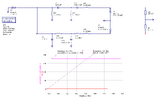This is the technique applied so as to obtain a wideband matching + balun for a bowtie antenna.
I have run a simulation:

The two 43.3 nH inductors are there to cancel each -j*118 antenna arm reactance. Does it make sense ?
I have remeasured the antenna + caps / inductors populated with my nanoVNA and have found R - j*20 ohm. R was in the 10 - 20 ohm range, can't remember, anyway, less than 50. i have made approximations for all of the matching network's elements, i.e. precise values were used for only 8 pF, 24 pF and 7.5 nH. What should I do next to at least get that reactance closer to zero ? The antenna is very deaf currently.
Thank you
I have run a simulation:

The two 43.3 nH inductors are there to cancel each -j*118 antenna arm reactance. Does it make sense ?
I have remeasured the antenna + caps / inductors populated with my nanoVNA and have found R - j*20 ohm. R was in the 10 - 20 ohm range, can't remember, anyway, less than 50. i have made approximations for all of the matching network's elements, i.e. precise values were used for only 8 pF, 24 pF and 7.5 nH. What should I do next to at least get that reactance closer to zero ? The antenna is very deaf currently.
Thank you
